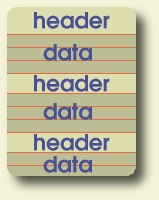|
2.1.5 Speech Files:
Microsoft's WAV Format The WAV audio format was developed by Microsoft and has become one of the primary formats of uncompressed audio. It stores audio at about 10 MB per minute at a 44.1 kHz sample rate using stereo 16-bit samples. The WAV format is by definition, the highest quality 16-bit audio format. It is also the largest at about 10 MB per minute of CD quality audio. The quality can be sacrificed for file size by adjusting the sampling rate, data width (i.e. 8-bits), and number of channels (up to 2 for stereo). For a comparison of audio formats, see Internet audio. Click here to download an example of a WAV file for our demonstration utterance. A detailed description of the WAV format can be found here. as well as many other places on the web (e.g., quick and dirty WAV layout). The header is organized as a sequence of fixed format values followed by data. A file can have multiple combinations of header and data, though many files just have one header and one data section. WAV file support in our environment is provided through a library developed by Silicon Graphics called Audio File Library that provides a uniform programming interface to many standard digital audio file formats. The actual interface to this library is hidden from the user (it is located in the class named AudioFile.
|
